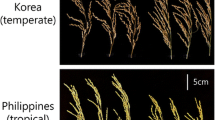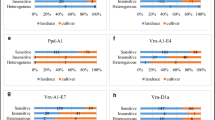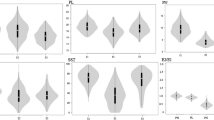Abstract
Temperature and photoperiod fluctuate rapidly in different seasons of the year, and analyzing their effects on rice yield components is crucial for adaptation of rice under various climatic conditions. To study the effects of seasonal changes on yield components, 168 recombinant inbred lines derived from a cross between two Oryza sativa L. indica varieties, Zhenshan 97 and Zhongzao 18 were grown for phenotype collection, in three different seasons, within a year. The results implied that temperatures across the three seasons played a crucial role in determining the trait effects. Spikelets per panicle (SPP), panicle length (PL) and plant height (PH) traits increased with high temperatures in middle season. Genetic analysis detected major quantitative trait loci (QTLs) qSPP10, qPL10 and qPH10 for SPP, PL and PH in the interval between markers RM1375 and RM3229 on chromosome 10, in all the three seasons. Two-way ANOVA showed that genotype by environment and QTL by environment interactions for these traits were highly significant (P < 0.0001). The region with a cluster of QTLs detected in all three seasons could be the preferred target to breeders in developing rice varieties that can be accustomed to different seasonal changes.





Similar content being viewed by others
References
Ashikari M, Sasaki A, Ashikari M, Ueguchi-Tanaka M, Itoh H, Nishimura A, Swapan D, Ishiyama K, Saito T, Kobayashi M, Khush GS, Kitano H, Matsuoka M (2002) Loss-of-function of a rice gibberellin biosynthetic gene GA20 oxidase (GA20ox-2) led to the ‘green revolution’. Breed Sci 52:143–150
Ashikari M, Sakakibara H, Lin S, Yamamoto T, Takashi T, Nishimura A, Angeles ER, Qian Q, Kitano H, Matsuoka M (2005) Cytokinin oxidase regulates rice grain production. Science 309:741–745
Cooper M (1999) Concepts and strategies for plant adaptation research in rainfed lowland rice. Field Crops Res 64:13–34
Cooper M, Somrith B (1997) Implications of genotype-by-environment interactions for yield adaptation of rain fed lowland rice: influence of flowering date on yield variation proc. Workshop, Plant breeding strategies for rain fed lowland rice in drought prone environments. Canberra, Australia, ACIAR 104–114
Fan CC, Xing YZ, Mao HL, Lu TT, Han B, Xu CG, Li XH, Zhang Q (2006) GS3, a major QTL for grain length and weight and minor QTL for grain width and thickness in rice, encodes a putative transmembrane protein. Theor Appl Genet 112:1164–1171
Hittalmani S, Huang N, Courtois B, Venuprasad R, Shashidhar HE, Zhuang JY, Zheng KL, Liu GF, Wang GC, Sidhu JS, Srivantaneeyakul S, Singh VP, Bagali PG, Prasanna HC, McLaren G, Khush GS (2003) Identification of QTL for growth- and grain yield-related traits in rice across nine locations of Asia. Theor Appl Genet 107:679–690
Hu ML, Zhang YX, Kong LN, Yang QH, Wang CM, Zhai HQ, Wan JM (2007) Quantitative trait locus for photosynthesis and its related physiological traits in rice (Oryza sativa L.). Acta Agr Sin 33(2):183–188
IPCC 2007: climate change (2007) The physical science basis. Contribution of working group I to the fourth assessment report of the intergovernmental panel on climate change. Cambridge University Press, Cambridge
Ishimaru K, Yano M, Aoki N, Ono K, Hirose T, Lin SY, Monna L, Sasaki T, Ohsugi R (2001) Toward the mapping of physiological and agronomic characters on a rice function map: QTL analysis and comparison between QTLs and expressed sequence tags. Theor Appl Genet 102:793–800
Ishimaru K, Ono K, Kashiwagi T (2004) Identification of a new gene controlling plant height in rice using the candidate-gene strategy. Planta 218:388–395
Jiang W, Lee J, Chu SH, Ham TH et al (2010) Genotype × environment interactions for chilling tolerance of rice recombinant inbred lines under different low temperature environments. Field Crops Res 117:226–236
Lanceras JC, Pantuwan G, Jongdee B, Toojinda T (2004) Quantitative trait loci associated with drought tolerance at reproductive stage in rice. Plant Physiol 135:384–399
Lin HX, Qian HR, Zhuang JY, Lu J, Min SK, Xiong ZM, Huang N, Zheng KL (1996) RFLP mapping of QTLs for yield and related characters in rice (Oryza sativa L.). Theor Appl Genet 92:920–927
Lincoln S, Daly M, Lander E (1993) Mapping genes controlling quantitative traits with MAPMAKER/QTL 1.1: a tutorial and reference manual, 2nd edn. Whitehead Institute Technical Report, Cambridge
Liu T, Shao D, Kovi MR, Xing Y (2010) Mapping and validation of QTL for spikelets per panicle and 1000-grain weight in rice (Oryza sativa L.). Theor Appl Genet 120:933–942
Mann CC (1999) Crop sciences seek a new revolution. Science 283:310–314
McCouch SR, Teytelman L, Xu Y, Lobos KB, Clare K, Walton M, Fu B, Maghirang R, Li Z, Xing Y, Zhang Q, Kono I, Yano M, Fjellstrom R, DeClerck G, Schneider D, Cartinhour S, Ware D, Stein L (2002) Development and mapping of 2, 240 new SSR markers for rice (Oryza sativa L.). DNA Res 9:199–207
Murai M, Takamure I, Sato S, Tokutome T, Sato Y (2002) Effects of the dwarfing gene originating from Dee-geo-woo-gen on yield and its related traits in rice. Breed Sci 52(2):95–100
Murray MG, Thompson WF (1980) Rapid isolation of high molecular weight DNA. Nucleic Acids Res 8:4321–4325
Nair S, Rao UP, Bennett J, Mohan M (1995) Detection of a highly heterozygous locus in recombinant inbrid lines of rice and its possible involvement in heterosis. Theor Appl Genet 91:978–986
Otsuka K, Kalirajan KP (2006) Rice green revolution in Asia and its transferability to Africa: an introduction. Dev Econ 44:107–122
Pooni HS, Jinks JL (1978) Predicting the properties of recombinant inbred lines derived by single seed descent for two or more characters simultaneously. Heredity 40:349–361
Qiao Y, Jiang W, Rahman M, Chu S, Piao R, Han L, Koh H (2007) Comparison of molecular linkage maps and QTLs for morphological traits in two reciprocal backcross populations of rice. Mol Cells 25:417–427
Saliba-Colombi V, Causse M, Gervais L, Philouze J (2000) Efficiency of RFLP, RAPD and AFLP markers for the construction of an intraspecific map of the tomato genome. Genome 43:29–40
Sasaki A, Ashikari M, Ueguchi-Tanaka M, Itoh H, Nishimura A, Swapan D, Ishiyama K, Saito T, Kobayashi M, Khush GS, Kitano H, Matsuoka M (2002) A mutant gibberellin-synthesis gene in rice. Nature 416:701–702
Spielmeyer W, Ellis MH, Chandler PM (2002) Semidwarf (sd-1), “green revolution” rice, contains a defective gibberellin 20-oxidase gene. Proc Natl Acad Sci USA 99:9043–9048
Temnykh S, Park WD, Ayres N, Cartihour S, Hauck N, Lipovich L, Cho YG, Ishii T, McCouch SR (2000) Mapping and genome organization of microsatellite sequences in rice (Oryza sativa L.). Theor Appl Genet 100:697–712
Temnykh S, Declerck G, Luashova A, Lipovich L, Cartinhour S, McCouch SR (2001) Computational and experimental analysis of microsatellites in rice (Oryza sativa L.): frequency, length variation, transposon associations, and genetic marker potential. Genome Res 11:1441–1452
Wang S, Basten CJ, Zeng ZB (2007) Windows QTL Cartographer 2.5. Department of statistics, North Carolina state University, Raleigh, NC. (http://statgen.ncsu.edu/qtlcart/WQTLCart.htm)
Weiss A, Hays CJ (2005) Calculating daily mean air temperatures by different methods: implications from a non-linear algorithm. Agric For Meteorol 128:57–65
Wu KS, Tanksley SD (1993) Abundance, polymorphism and genetic mapping of microsatellites in rice. Mol Gen Genet 241:225–235
Xiao J, Li J, Yuan L, Tanksley SD (1996) Identification of QTLs affecting traits of agronomic importance in a recombinant inbred population derived from a subspecific rice cross. Theor Appl Genet 92:230–244
Xing YZ, Tan YF, Xu CG, Hua JP, Sun XL (2001) Mapping quantitative trait loci for grain appearance traits of rice using a recombinant inbred line population. Acta Bot Sin 43(8):840–845
Xing YZ, Tan YF, Hua JP, Sun XL, Xu CG, Zhang Q (2002) Characterization of the main effects, epistatic effects and their environmental interactions of QTLs on the genetic basis of yield traits in rice. Theor Appl Genet 105:248–257
Xing YZ, Tang WJ, Xue WY, Xu CG, Zhang Q (2008) Fine mapping of a major quantitative trait loci, qSSP7, controlling the number of spikelets per panicle as a single Mendelian factor in rice. Theor Appl Genet 116:789–796
Xue W, Xing Y, Weng X, Zhao Y, Tang W, Wang L, Zhou H, Yu S, Xu C, Li X, Zhang Q (2008) Natural variation in Ghd7 is an important regulator of heading date and yield potential in rice. Nat Genet 40:761–767
Yin X, Kropff MJ, Goudriaan J, Stam P (2000) A model analysis of yield differences among recombinant inbred lines in barley. Agron J 92:114–120
Yoon DB, Kang KH, Kim HJ, Ju HG, Kwon SJ, Suh JP, Jeong OY, Ahn SN (2006) Mapping quantitative trait loci for yield components and morphological traits in an advanced backcross population between Oryza grandiglumis and the O. sativa japonica cultivar Hwaseongbyeo. Theor Appl Genet 112:1052–1062
Yoshida H, Horie T, Shiraiwa T (2006) A model explaining genotypic and environmental variation of rice spikelet number per unit area measured by cross-locational experiments in Asia. Field Crops Res 97(2–3):337–343
Zhang YS, Bai XF (2008) A simple, rapid and high- resolution banding method in polyacrylamide gels. Hereditas (Beijing) 30:251–254 (in Chinese with an English abstract)
Zhang YS, Luo LJ, Xu CG, Zhang QF, Xing YZ (2006) Quantitative trait loci for panicle size, heading date and plant height co-segregating in trait-performance derived near isogenic lines of rice (Oryza sativa). Theor Appl Genet 113:361–368
Zhuang JY, Lin HX, Lu J, Qian HR, Hittalmani S, Huang N, Zheng KL (1997) Analysis of QTL-environment interaction for yield components and plant height in rice. Theor Appl Genet 95:799–808
Acknowledgments
The authors kindly thank farm technician Mr. J.B. Wang for his excellent field work. Kovi M.R. gratefully acknowledges the China Scholarship Council (CSC) for funding his Ph.D.
Author information
Authors and Affiliations
Corresponding author
Rights and permissions
About this article
Cite this article
Kovi, M.R., Bai, X., Mao, D. et al. Impact of seasonal changes on spikelets per panicle, panicle length and plant height in rice (Oryza sativa L.). Euphytica 179, 319–331 (2011). https://doi.org/10.1007/s10681-010-0332-7
Received:
Accepted:
Published:
Issue Date:
DOI: https://doi.org/10.1007/s10681-010-0332-7




